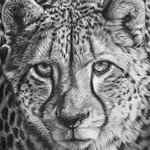Wish you were here? The marvellous Danish artist Christen Købke climbs the palace rooftops to give you the summer sky. Here is the dark roof ridge, the cool blue water beyond, the landscape repeating these horizontals in ever hazier stripes beneath a motionless sky that fills three-quarters of the painting. Everything contributes to this hymn to warm light and panoramic skies, the kind of praise no photograph can properly muster. And it’s all witnessed on the spot by strange surrogates: a solid brick chimney and an elaborate spire both face the sky amazed, as if anticipating the art of Edward Hopper.
The Art History evolution of depicting weather, clouds and skies!
Throughout art history movements, the way artists have depicted the landscape, weather and nature has evolved. I want to examine this and understand the changes that occurred and why this may be – linking it to what type of movement and style I relate to most when I try and depict vast open skies, clouds and thunderstorms.
The earliest form of painting nature and skies begins with Medieval art where the depictions are centred around the night sky, the sun and the stars. Astrology was key in this time period and led to medicines also being based around the solar system, quite minimal and illustrative impressions.
Artists include: Cristoforo de Predis, Harley MS
Renaissance art proved to be the beginning of the realistic portal of skies, clouds and weather. Usually acting as a background for a scene to play out in the foreground, with intense light and shade as new colours are discovered e.g. Gamboge, a bright and translucent yellow pigment.
Artists include: Charles Le Brun, Titian
There was a turn in the early 16 th century as Mannerism came into play. With dark and dramatic stormy skies linked into the background, portrays of the clouds became less realistic, merging with the human form to create curves.
Artists include: El Greco
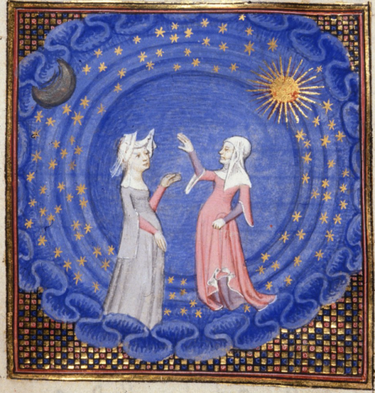





My interests start to peak around the Baroque era, with their use of pastels depicting sunsets/sunrises and using clouds to signify the angels/Christ and heaven. Sunlight is used a lot to form this pastel lighting.
Artists include: Antonio Verrio, Louis Laguerre
A similar style that came after the Baroque movement was Rococo, this was by far the most over the top and dramatic style in art history. It was very detailed and intricate, with clouds and skies made much more of a feature especially with the merge with landscape and greenery. more realistic and a mixture of daytime and night-time linking into the type of painting created.
Artists include: François Boucher, Jean-Honore Fragonard




The art movement that speaks the most to me is Romanticism. The dark, dramatic, stormy and realistic elements entice me into every piece. We begin also to portray the weather much more accurately bringing in rain and storms. Plein-air painting began meaning artist could examine the weather in real life out in the open, experiencing the outdoors as they happen – emphasizing the imagination. Poetry also began influencing art e.g. William Blake
Artists include: J.M.W Turner, John Constable



Moving on from this, Realism began with more subtle and true to life impressions, no exaggerated clouds just the normal western ‘dull’ weather depicting everyday life, usually dark and dull as depicting farmers/labourers.
Artists include: Gustave Courbet, Jean-François Millet


The rest of these art history movements are the ones that link least to my work however I still wanted to include them as its helpful to understand the different depictions and how they change.
Impressionism – An ‘impression’ of the skies, exaggerated vibrant colours, brush marks signify clouds rather than realistic. Also muted, warm colours. Landscape become more of a prominent feature by themselves rather than background.
Artists include: Claude Monet
Post-Impressionism – Becoming much more abstract, clouds and skies become movement, showing almost video like frames. E.g. Van Gogh, reflections and water become important echoing what the sky is like. Similar to impressionism whereby using many vibrant colours to depict what ‘isn’t there’. Pointillism.
Artists include: Vincent Van Gogh
Fauvism – Intense colour, line, and brushwork, a bold sense of surface design, and flat composition. The separation of colour from its descriptive, representational purpose was one of the core elements that shaped this movement. Less detailed. No need to depict what is there anymore.
Artists include: Henri Matisse, André Derain

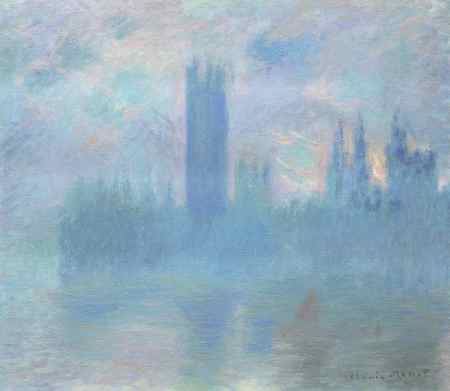




Expressionism – Distortion of form and strong colours to display anxieties and raw emotions, showing movement through colour, bold mark making.
Artists include: Edward Munch, Oskar Kokoschka
Cubism – Block shapes to signify clouds, fragmented objects through abstraction, lines, little curves, more realistic colour palette compared to expressionism but depicting landscapes and skies in an abstract way.
Artists include: Pablo Picasso, Georges Braque
Surrealism – Using skies as an illusion to create the effect of space and a dream like quality – slightly linking into the baroque where it was almost depicted as other worldly (heaven) moving into a more pastel colour palette but still vibrant. Realistic but with a surrealism element – slightly cartoon like. Unconscious mind to depict revelations found on the street and in everyday life.
Artists include: Salvador Dalí, Paul Nash






A key movement also in relation to my work is Abstract Expressionism. Almost completely unrecognisable as to what its depicting, still hints of what’s there but more of an impression rather than reality. Big brushstrokes to signify power in the sky. Showing movement too, instead used spontaneity and improvisation to create abstract works of art. This included colossally scaled works whose size could no longer be accommodated by an easel. Instead, canvases would be placed directly upon the floor. I feel this movement in particular lends itself it my project as although I want to depict weather and the sky in a way that can be understood, the impression is a key aspect. Allowing the audience to decipher first and then understand later is key.
Artists include: Jackson Pollock, Sam Francis


Some other movements that don’t relate so much to my project are below, I thought I would continue to research how the depiction of skies and weather have changed just to understand fully.
Pop Art – Cartoony and comic book like, abstract and block colour (similar to cubism), usually depicting people or objects, landscapes are strayed away from.
Artists include: Roy Lichtenstein
Minimalism – Slight depictions of clouds but with minimal brushstrokes, fewer colours, limited pallet – use blocks sometimes, starting to link back to night-time and stars.
Artists include: Donald Judd
Conceptual art – fantasy like, focused on ideas and concepts, there was no distinct style or form. Wide colour pallet much more individual as to not holding one style as all ideas are different and are portrayed differently.
Artists include: Olafur Eliasson, Richard Long





Finally, we get to the 21 st century and Contemporary art takes over and art becomes much more individual, a mixture. Landscapes portrayed realistically with link to romanticism but also combination with abstract expressionism (mark making etc). Digital art starts to make an appearance along with feminism art and other smaller movements. The most varied of all the movements.
Artists include: Virginia Katz, Ian McKeever


In summary, the movements that stand out the most to me include Romanticism, with artists such as Turner acting as inspiration along with Impressionism, including artists such as Claude Monet. Possibly the most influential movement is Abstract Expressionism, with the abstract yet conceptual element behind each piece. Contemporary also plays a large part in all my work as I am working in that movement currently so am influenced by other artists such as Virginia Katz (land art type) as well as Ian McKeever. Overall, it has been so helpful to see how the depiction of weather, skies and clouds have evolved overtime and has also allowed me to decipher which movements I have naturally identified with in relation to others.
Walter De Maria
The Lightning Field (1977) Dia Art Foundation, New York
The American artist Walter De Maria is best known for 1977’s The Lightning Field. A rectangular grid in New Mexico measuring one mile by one kilometre and formed of 400 stainless steel lightning rods, it creates an ultra-minimalist arena for witnessing meteorological activity. That is the formal description. But for the few who have actually seen it (entrance is highly restricted, and unofficial photography banned) the point, and power, of this work of land art is the way it connects the sky directly to the world, drawing down bolts of lightning – writing on the sky.
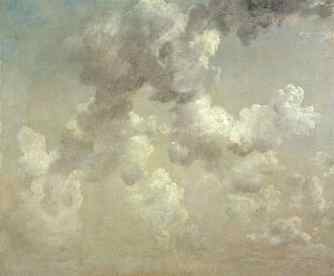
John Constable
Study of Clouds (1822) Ashmolean Museum, Oxford
It is never a sunny day in Constable country – there is always a cloud in the sky. But so accurate are these clouds that awed meteorologists can sometimes calculate the season and even the hour from his skies, which Constable famously called “the chief organ of sentiment” in any landscape. Here, the view is Hampstead Heath on a September morning. But what’s remarkable is not so much the exactitude of observation as the way Constable’s painted shapes materialise on the canvas without resolving into patterns or fixed forms: just like a sky full of clouds.
JMW Turner
Dawn in Northumberland and the mist partly transmits and partly reflects the vivid yellow sunrise, forming a diffuse mirror image of the sky above. Turner shows the sun transforming matter into energy, turning the substantial world into an airy mirage in which cattle and castle almost disappear and the land is as vaporous as the sky. Practically any Turner sky could appear on this page but the late skyscapes, generally painted at sunrise, often on the spot, and very nearly abstract, are closer to the sublime than anything in English art.
Easter Morning (c1828-35) Thyssen-Bornemisza Museum, Madrid
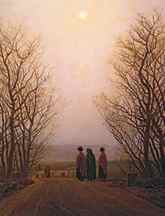
This is the sky as a medium of revelation through which God shows himself, or in this case his only son. The painting has a mystical symmetry characteristic of this melancholy German Romantic. Three women – think of the three Marys at the foot of the cross – walk towards a misty golden vision, a body of light rising between the skeletal arms of the wintry trees. But green shoots are beginning to appear out of the dead land, spring is dawning and humankind is going forwards. The sky is a celestial sign: an evocation of the risen Christ.

